Artificial intelligence (AI) has been utilized to uncover hidden structural vulnerabilities in St. Peter’s Basilica, located in the Vatican City. This marks the first time that such technology has been used to identify imperceptible damage in the famous Catholic church. The project, named La Basilica di San Pietro, was a collaborative effort between Microsoft, the Vatican, and Iconem, a French startup specializing in digital preservation.
To create a digital twin of the Basilica, drones, cameras, and lasers were employed to capture over 400,000 detailed images of both the exterior and interior of the building, including its intricate mosaics, frescoes, and sculptures. Through AI analysis of this data, previously unseen cracks and fissures were detected, providing crucial information for restoration purposes. Additionally, the AI revealed lost mosaic tiles and unveiled a detailed ceiling that had been concealed.
Brad Smith, vice chair and president at Microsoft, emphasized the importance of leveraging technology like AI for historical preservation, noting that it plays a significant role in conserving our past. Dr. Noha Saleeb, an associate professor at Middlesex University, highlighted the capability of AI algorithms to identify structural damage that may not be visible to the naked eye, as well as predict potential areas of deterioration by analyzing patterns in collected data.
The utilization of digital twin technology in historical buildings has proven to be invaluable, as seen in projects like the 3D digital model of Notre-Dame Cathedral in Paris following the devastating fire in 2019. Dr. Saleeb emphasized the critical role that digital replicas play in restoration efforts, underscoring their necessity in preserving heritage sites. Professor Mohamed Gamal Abdelmonem from the University of York echoed this sentiment, noting the importance of laser and imaging technology in creating accurate reproductions of historical sites.
The unveiling of the project at the Vatican, attended by Pope Francis and Mr. Smith, marks a milestone in historical preservation efforts. La Basilica di San Pietro is now accessible online, allowing individuals worldwide to experience the intricacies of the Basilica with the same level of detail as in-person visitors. Father Francesco Occhetta, a coordinator at the Vatican, described the collaboration between human intelligence and AI as a bridge to the future, transcending geographical boundaries and making the Basilica accessible to people around the globe.










